Plasticity and toughness in bone
DOI: 10.1063/1.3156332
Built primarily from collagen molecules, mineral crystals, water, and ions, bone forms the lightweight but tough and protective load-bearing framework of the body. Bone’s elastic modulus—its stiffness during elastic deformation—spans 15–25 GPa, roughly a third of metallic aluminum; its strength, the applied stress at the onset of plastic deformation, is a few hundred MPa, comparable with alumina ceramics; and its fracture toughness, a measure of the material’s resistance to fracture, is typically 3–10 MPa/m, some 3 to 10 times as high as silicon.
Although other materials may be mechanically superior, bone is unique for its capacity for self-repair and adaptation. 1 Unfortunately, aging-related changes to the musculoskeletal system increase bone’s susceptibility to fracture, 2 which can be especially serious in the case of the elderly. Several variables are involved, among them the frequency of traumatic falls, prior fractures, and loading history, but bone tissue itself appears to deteriorate with age. 3 A primary factor in that deterioration is bone quality, a loosely defined term used to describe some, but not yet all, microscopic and macroscopic structural characteristics that influence bone’s mechanical properties.
Traditional thinking on bone’s deterioration has focused on bone quantity—described by the bone mass or bone-mineral density (BMD)—as a predictor of fracture risk. For example, the elevation in bone repair activity, known as remodeling, among aging postmenopausal women in particular can lead to osteoporosis. Disease statistics from the National Osteoporosis Foundation bear out the magnitude of the problem: One in two women and one in four men over the age of 50 will suffer an osteoporosis-related fracture over their remaining lifetimes.
Mounting evidence indicates that low BMD, however, is not the sole factor responsible for the fracture risk. A landmark study 20 years ago by Sui Hui and colleagues showed a roughly 10-fold increase in fracture risk with aging, independent of BMD. 2 That result and the fact that BMD alone cannot explain therapeutic benefits of antiresorptive agents in treating osteoporosis emphasize the need to understand the factors that control bone quality.
Although bone is a simple composite of a mineral phase, calcium phosphate–based hydroxyapatite, embedded in an organic matrix of collagen protein, its structure is highly complex and hierarchical: Features at smaller length scales form the basis for features at higher ones, 4 as shown in figure 1. A vital question is the origin of the material’s fracture resistance in those various structural elements.

Figure 1. Multiscale structure of bone. Collagen protein molecules known as tropocollagen form from three chains of amino acids and provide the structural basis for mineralized collagen fibrils, the basic building blocks of bone. Several collagen fibrils, each linked by an organic phase, form fibril arrays. Each array makes up a single collagen fiber, and several fibers form geometric patterns that provide structure—more precisely, lamellar structure—to the cellular components of bone. The boundaries between packets of fibers create what are known as lamellar interfaces. That microstructure forms distinct mesoscale arrangements: compact, or cortical, bone (the dense material found at the surface of all bones) and spongy, or cancellous, bone (foamlike material whose struts are some 100 µm thick and separated by 1-mm-wide holes). Macroscopic cortical bone is complex. Osteons surround and protect blood vessels. Osteocytes, which pervade the whole tissue, are mature bone cells connected to each other through thin channels called canaliculi.
(Adapted from ref. 4, Weiner and Wagner, and from G. J. Tortora,
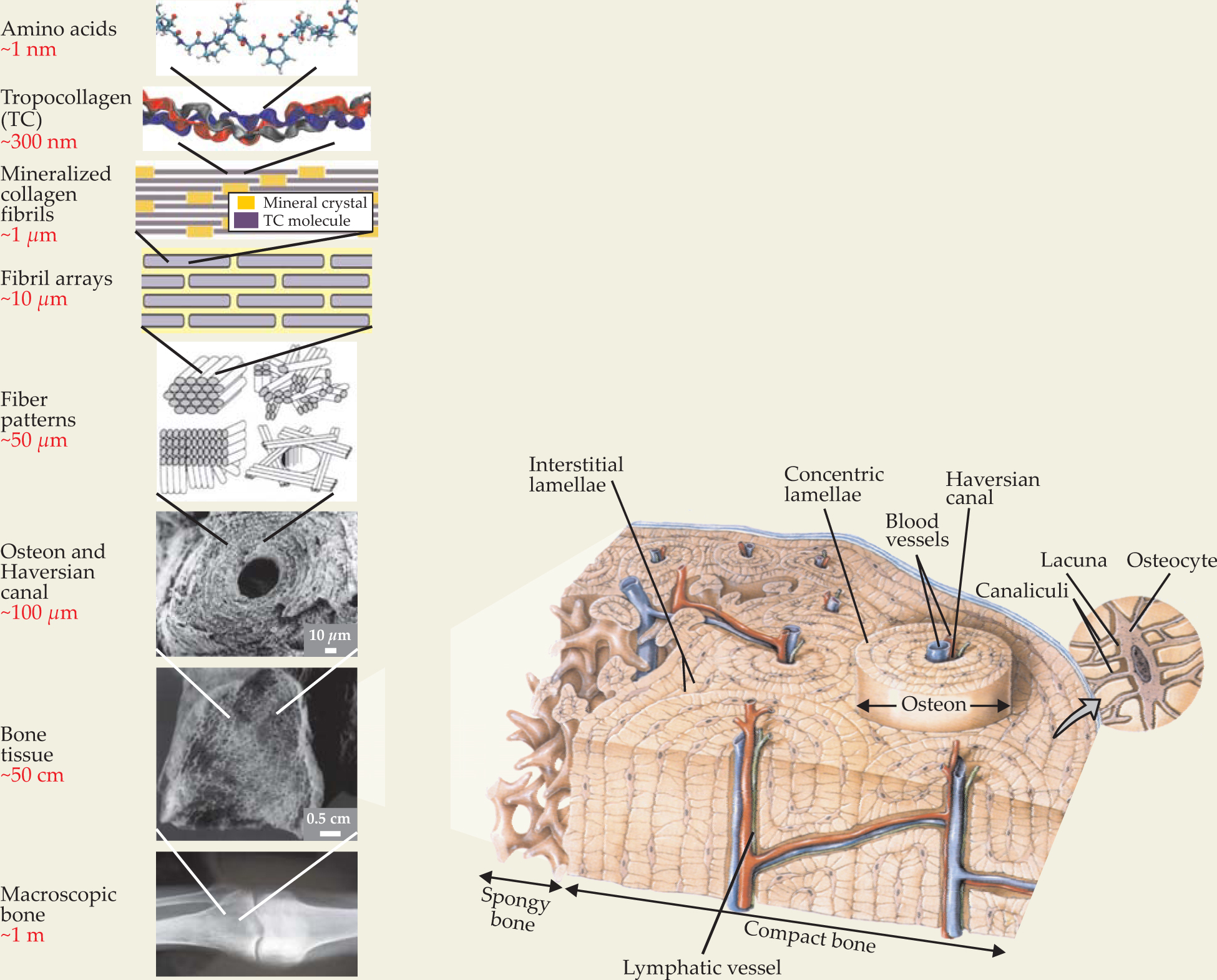
The physics of fracture is characterized by dissipation of elastically stored energy from an applied load. Materials begin to fracture when the elastic energy dissipated by the advance of a crack is equal to or larger than the energy required to create a new surface. Thus, the more energy-dissipation (or toughening) mechanisms that exist, the more difficult it is to break a material. One hypothesis is that in bone, toughening mechanisms exist at all characteristic length scales. But as bone changes with age, so can structural features and phenomena—from the cross-linking of collagen proteins to the actual macroscopic path taken by a crack. Unfortunately, it’s difficult to discern the roles that structural constituents play during the initiation of a crack and the crack’s subsequent propagation.
If the links between biological factors, bone structure (from molecular to macroscopic levels), fracture mechanism, and toughness can be established, then the concept of bone quality will hopefully become a quantifiable entity. Moreover, once the structural mechanisms underlying any change in bone quality are identified, it is entirely feasible that new and perhaps more effective therapeutic treatments can be developed to treat bone disorders.
In this article, we outline what is known about how bone derives its resistance to permanent deformation and fracture by examining the multidimensional nature of its structure.
Hierarchical structure
Along with materials such as hair, skin, and spider silk, bone belongs to a family of biological proteins that constitute critical building blocks of life. Not surprisingly, bone provides a variety of mechanical, synthetic, and metabolic functions for the body. 5 Beyond its support for our skeletal frames, bone enables sound transduction in the ear, facilitates blood production in its marrow—the interstitial spaces of what is known as spongy, cancellous, or trabecular bone—and provides a reservoir of calcium and phosphorous. An understanding of how microscopic structural features combine into macroscopic ones is thus vital to discern the links between structural organization and function.
The smallest-scale features of bone include a protein phase composed of tropocollagen molecules, each built from three polypeptides arranged in a triple helical geometry and stabilized by hydrogen bonding between different amino-acid building blocks (see figure 2). The soft collagen gives bone its elasticity and the ability to dissipate energy under mechanical deformation. The most abundant protein on Earth, collagen is arguably also the most important structural protein in biology. It is vital in tissues such as cartilage, skin, and the eye’s cornea, and can stretch up to 50% tensile strain with stresses near 10–20 GPa before breaking. 6

Figure 2. (a) A triple helical tropocollagen molecule in side view and on end. (b) Tropocollagen’s force–extension behavior up to 40% tensile strain. Also shown are the number of hydrogen bonds broken as a function of strain on a molecular segment 30 amino acids long. During the first stage of deformation—at less than 10% strain—that number remains close to 30, which corresponds roughly to one H bond for each amino-acid triplet. As the tropocollagen straightens, H bonds gradually break until 25% strain is reached. After that point the intermolecular H bonding remains nearly constant, close to 15, because the increase in force is due to backbone stretching. Indeed, in that regime H bonds appear to continuously break and re-form along the peptide.
(Adapted from ref. 6, Gautieri, Buehler, and Redaelli.)
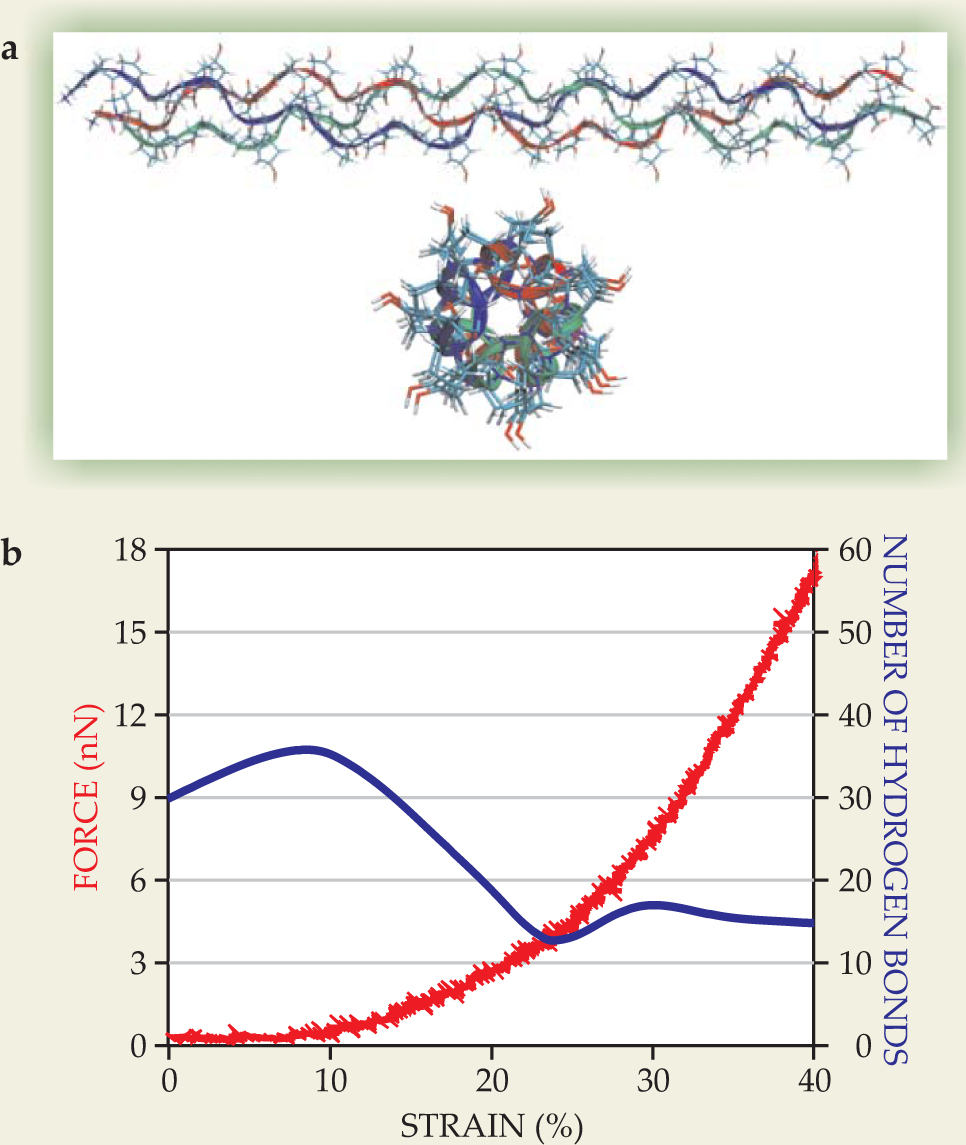
Staggered arrays of tropocollagen molecules form collagen fibrils, which themselves arrange into arrays. Collagen fibrils are particularly significant because they act as the structural template for bone formation: Tiny crystals of hydroxyapatite assemble in the gap between collagen fibrils, illustrated in figure 3, and the fibrils become mineralized as the bone tissue grows and matures. The mineral crystals grow to a few tens of nanometers in length but remain quite thin, roughly 1–2 nm, in the out-of-plane direction. Each array of fibrils, connected by a protein phase that provides additional dissipative properties by acting as glue, twists into an individual fiber.

Figure 3. Mineralization during bone formation (a) is thought to start in the gaps between collagen fibrils, illustrated here as staggered 300-nm-long rods. As the fibrils mature, they become coated with mineral plates. (b) This atomic force microscope image of bone (and the one on this issue’s cover) shows the coating of mineral plates. (c) A schematic representation suggests how the fibrils might deform near compressive failure, as in the collapse of a vertebra, say, as interfibrillar bonds break. The glue-like bonding material, which resists the separation of fibrils, also resists their sliding relative to each other during failure of compact bone in tension.
((a) Adapted from W. J. Landis et al.,
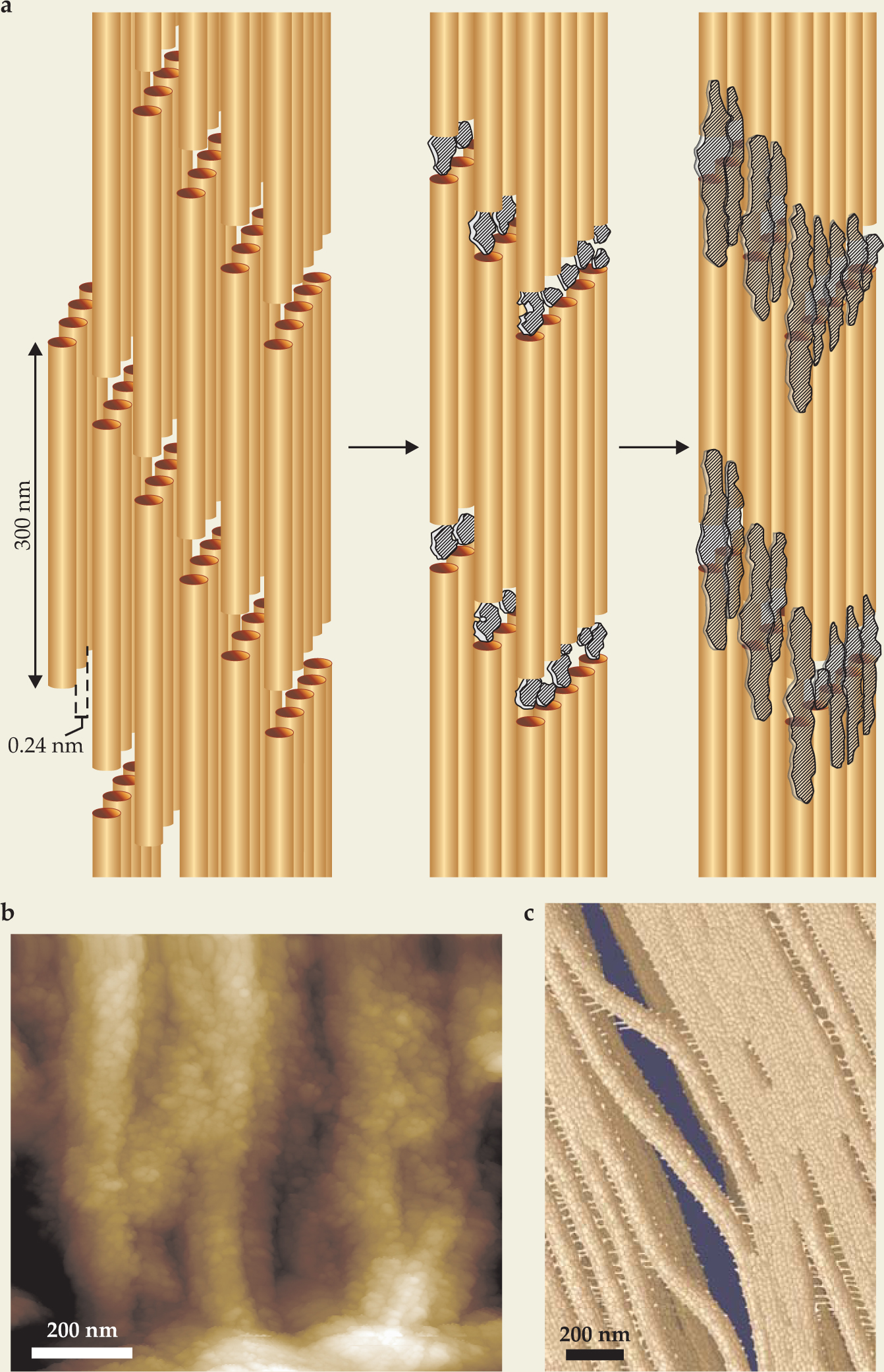
Those fibers, in turn, arrange into randomly oriented, parallel, tilted, or woven bundles in bone. The bundles are organized at microstructural length scales into a lamellar structure, with adjacent lamellae some 3–7 µm thick. 4 A characteristic cylindrical structure called an osteon, also known as a Haversian system, forms the next hierarchical level of bone. Some 200–300 µm in diameter, the osteons contain vascular channels that are surrounded by lamellar rings with so-called cement lines at their outer boundaries. They also contain cells that dissolve old bone and renew tissue. Thanks to that remodeling, the structure of bone is highly dynamic. For a deeper treatment of the crucial effect of remodeling on many of bone’s remarkable properties, such as its adaptability to changing mechanical load patterns, see references and .
At the macroscopic scale, differences in the density of bone tissue become apparent. Compact, or cortical, bone, the principal focus of this article, is essentially solid, just porous enough to accommodate cells and a vascular network. It makes up the dense material found at the surface of all bones. Spongy bone is extremely porous and fills the insides of many bones.
In addition to the hierarchical complexity, the composition and the structure of both compact and spongy bone vary with factors such as skeletal site, age, sex, physiological function, and mechanical loading. Those factors, when combined with the vascular network, make bone quite heterogeneous indeed. Moreover, recent analyses of the osteon structure show a chiral arrangement of fibers that lend different mechanical properties to compact bone compared with the surrounding interstitial bone that forms in the gaps between the growing osteons. 8
Strength and deformation
The mechanical properties of its constituents largely control the mechanical properties of bone, especially its strength and plasticity. They also depend strongly on the scale of the observation. Recent experimental and theoretical studies offer insight into mechanisms that underlie those properties, most notably through multiscale modeling and techniques such as transmission electron and x-ray microscopy, force microscopy, and Raman spectroscopy, which can examine bone properties at ever smaller length scales. Results suggest that permanent deformation, or plasticity, in bone occurs from multiple, concurrent deformation mechanisms that are active at all hierarchical levels.
But although researchers have identified individual mechanisms at work, no integrated model of plastic deformation in bone has yet emerged; plasticity at molecular scales is particularly challenging to identify. The breaking of hydrogen bonds is crucial to large deformation, but they re-form when the applied force is removed. Figure 2 shows a plot of how the amount of H bonding in a single collagen molecule is affected by progressive strain. The force required to break those bonds strongly depends on the deformation rate, which provides a mechanism to dissipate energy under rapid loading. Indeed, such breaking of H bonds can be regarded as a viscoelastic effect. That suggests that plastic deformation in bone must also involve larger-scale mechanisms such as intermolecular sliding, which would not be reversible unless remodeling of bone occurs.
To appreciate the deformation mechanisms in bone, consider again its different structural levels. Individual collagen molecules deform by stretching and unwinding due first to entropic and then to energetic mechanisms that involve H-bond breaking. In collagen fibrils, molecular stretching competes with intermolecular sliding and the breaking of both weak and strong bonds between tropocollagen molecules. Those sliding motions enable bone to endure large plastic strain without suffering a catastrophic “brittle” failure. The specific structure of intermolecular cross-links thus plays a crucial role in defining just how the material deforms. Aged collagen tends to show a higher cross-link density than young collagen. And the larger the cross-link density, the lower the material’s ability to dissipate energy before breaking. 9
The presence of hydroxyapatite in bone is critical to its stiffness. Experiments show a continuous increase in Young’s modulus—up to a factor of three for high mineral contents—as collagen fibrils mineralize. Molecular modeling and experimental x-ray analysis suggest that continuous glide between tropocollagen molecules and between hydroxyapatite minerals and tropocollagen molecules, initiated by slip at the hydroxyapatite–tropocollagen interface, dissipates a great deal of energy once the material starts to yield, or deform, under stress. 9 Larger stresses in the fibrils, preserved and strengthened thanks to mineralization, can be maintained after slipping begins because of resistance to that slip at the interface between the tropocollagen molecules and hydroxyapatite minerals; the resistance leads to a several-fold increase in energy dissipation.
At larger, submicrometer scales, the relative motion of mineralized collagen fibrils is the origin of postyield, or permanent, deformation in bone; it is resisted by the interfibrillar matrix of primarily noncollagenous proteins in an aqueous environment. 10 At the level of individual mineralized collagen fibrils, intermolecular slip is also an important mechanism of energy dissipation. 5,9 In the vicinity of a crack, the slipping leads to the formation of a plastic zone where elastic energy can be dissipated to oppose further spreading of the fracture. That process turns out to be a dominant toughening mechanism in most ductile materials such as copper and nickel.
At somewhat coarser levels, the toughness of bone has been tied to the presence of “recoverable” or sacrificial bonds. 11 Distinct mineralized collagen fibrils can be considered to be glued together through such bonds, as illustrated in figure 3. During deformation and fracture events, force spectroscopy using an atomic force microscope indicates that the bonds break at a fraction (roughly 0.1–0.5) of the force required to break the backbone of the macromolecules. Moreover, in the aqueous environment that exists between the fibrils, the bonds can re-form just as the H bonds do at the single collagen molecule level and thus provide a continuous resistance to fracture.
Leading candidates for macromolecules with sacrificial bonds are the heavily phosphorylated protein polymers such as osteopontin and sialoprotein that occur in bone and are known to be excellent glues. Indeed, osteopontin has been implicated in sticking deposits to blood-vessel walls. One key to the polymers’ ability to act as glues in an aqueous environment lies in the negatively charged phosphate groups that can form relatively stable bonds with other phosphate groups and with negative charges on surfaces—the mineral plates in bone, for example—in the presence of divalent positive ions like Ca++.
Evidence for a sacrificial-bond mechanism is strongest in spongy bone. Specifically, using high-speed photography, researchers have found that macroscopic “whitening”—the scattering of light that occurs when interfaces open between mineralized fibrils—precedes fracture under physiologically relevant conditions.
Fracture and toughness
Just as plasticity in bone develops from processes at different length scales, so does toughness. As noted above, deformation of the mineralized collagen fibrils toughens bone tissue by forming plastic zones around crack-like defects. Those zones protect the integrity of the entire structure by allowing energy to dissipate in a localized area of the bone. Mineralized collagen fibrils are thus able to tolerate microcracks several hundred micrometers in length without causing any macroscopic failure of the tissue. 9 Indeed, microcracks are typical in bone. They usually form at weak interfaces and are essential for many of the toughening mechanisms in bone, notably crack bridging and crack deflection, which predominate at larger length scales, as described later. Microcracking may also play a role in bone remodeling by signaling combinations of cells to operate in concert: osteoclasts that dissolve and remove old bone and osteoblasts that create new bone and are responsible for the mineralization process. 7
The toughness of bone, in particular cortical bone, is a function of the path that a crack follows through tissue and the crack’s relation to the bone-matrix structure. Perhaps surprisingly, the main structural feature that appears to control toughness, the osteon, is relatively large, spanning several hundred micrometers. 12 As in most biological materials, the structural features provide toughening mechanisms that are active during crack growth rather than crack initiation.
Fracture can be thought of as a competition between intrinsic damage mechanisms that act ahead of the crack tip to promote cracking and extrinsic crack-shielding mechanisms that act primarily behind the tip to inhibit cracking. 13 Some toughening mechanisms serve to limit the microstructural damage. For example, plasticity ahead of the crack dissipates energy and locally reduces stresses by blunting the crack tip.
Other mechanisms do not necessarily increase bone’s inherent resistance to fracture but instead “shield” the crack tip from the applied driving force responsible for crack propagation. Those extrinsic mechanisms, which are the main source of micro- and macroscopic toughness in many biological materials, require the crack’s presence because they operate primarily in the wake of its tip and thus give rise to crack-size-dependent behavior.
Crack bridging is one example of an extrinsic mechanism. Intact fibers in composite materials, collagen fibers in bone, or interlocking grains in ceramics can bridge a developing crack and carry the load that would otherwise be used to drive the crack deeper into the material. 13 The deflection and twist imparted to a crack by osteons is another example. The diversion of a crack from the direction of maximum tensile stress dramatically slows its progress. 14
Both mechanisms operate, somewhat counterintuitively, through the presence of microcracks, which actually toughen the bone by relieving locally high stresses—provided the microcracks are not so extensive that they cause catastrophic failure (see figure 4). 14,15 Microcracks most often form at cement lines, the refractile boundaries of the osteons, and to a lesser extent at other (lamellar, for example) interfaces. Accordingly, they are typically spaced tens to hundreds of micrometers apart and primarily aligned along the long axis of the bone.

Figure 4. Toughness mechanisms in bone are evident at length scales from submicrometers to hundreds of micrometers in these scanning electron micrographs. Defined as resistance to fracture, toughness can be measured in terms of stress intensity at the tip of a crack. (a) Crack deflection and twist: As a crack (barely visible here) emerges from a notch, it encounters microcracks at the weak boundaries of the osteons (one marked with an arrow). The microcracks consume energy and may cause the growing crack to grossly deviate from the direction of maximum tensile stress, an effect that increases a bone’s toughness by as much as 3–20 MPa
(Adapted from ref. 14, Nalla, Kinney, and Ritchie.)
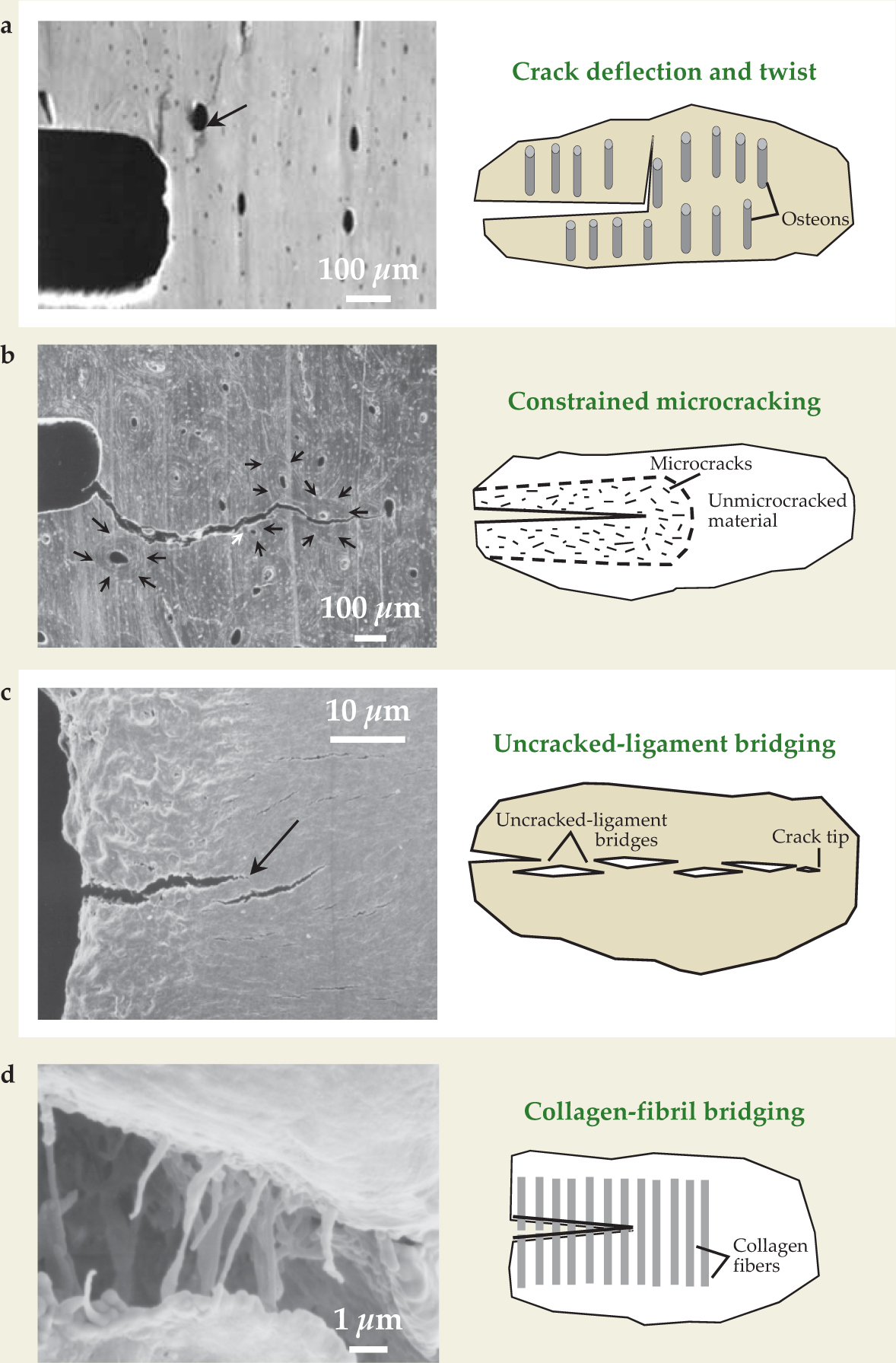
That orientation has a direct bearing on the strong anisotropy in bone’s toughness; bone is far more difficult to break than it is to split. And recent measurements indicate that after only 500 µm of cracking, the resistance to crack propagation, or toughness, is more than five times as high in the transverse (breaking) direction as in the longitudinal (splitting) direction. 14 Crack paths are very different in those two orientations. In the transverse direction, microcracks at cement lines are roughly perpendicular to a crack’s path, where they act as delamination barriers. The barriers blunt any growing cracks and can give rise to highly tortuous and twisted crack paths and extremely rough fracture surfaces. The high toughness follows from the reduced local stress intensity due to blunting, because a crack must reinitiate at each barrier to continue propagating and because the gross deviations in the crack’s path from the plane of maximum stress greatly diminish the local stress intensity at the tip. Bone continues to crack only through higher applied loads. In the longitudinal direction, conversely, cement-line microcracks are aligned roughly parallel to the growing crack; their formation alongside and ahead of the crack tip leaves locally intact regions that can act as bridges across the crack and can carry loads that would otherwise be used to promote cracking, a mechanism known as uncracked-ligament bridging. 14
Deterioration with age
The risk of bone fracture increases markedly with aging, as a consequence of a loss in bone mass (osteoporosis) and a significant degradation in bone quality. Fracture-toughness measurements on 34- to 99-year-old human cortical bone show some 40% reduction in the crack-initiation toughness and almost complete elimination of the crack-growth toughness with increasing age. 12 The reasons for that are complex and not completely clear. 15
At the nanoscale, distinct changes in the collagen environment occur, specifically in the degree of cross-linking. At the submicrometer scale, the nature and properties of individual collagen fibrils deteriorate. And at scales between 1 and 100 µm, bone’s structure changes due to an increased density of osteons, which have perhaps the largest effect on the macroscale fracture toughness. 12
With progressive aging, bone is remodeled: Growing cement lines sever the tiny canals that connect interstitial bone cells, a process that leads to cell death. 16 Because the cement lines are prime sites where microcracks form, the increased osteon density gives rise to a higher microcrack density, which can be associated with a diminished crack-initiation toughness. Furthermore, smaller uncracked-ligament bridges will span the developing crack. Such age-induced degradation in the potency of crack bridging in bone can be directly measured and is a major reason for the severe reduction in fracture resistance. 12,15
The fracture of spongy bone is worth considering in the context of aging because the main types of osteoporotic bone fracture in humans are hip fractures. Those fractures usually involve the neck of the femur, which is filled spongy bone, or the collapse of vertebrae, which contain very thin cortical shells and are also primarily spongy bone. With age, the density and diameter of the struts decrease, especially among postmenopausal women. Figure 5 shows the marked difference in spongy-bone architecture in a young man and an elderly woman. Researchers regard that change in bone quantity as the most responsible for the age-related fracture risk in spongy bone, although internal changes in the bones’ structure with age are also likely to affect its toughness in ways analogous to those in cortical bone. 17

Figure 5. Spongy bone from inside vertebrae obtained from human donors, specifically (a) a 21-year-old male, and (b) a 65-year-old female. The more open architecture of the elderly woman’s bone would be expected to be less fracture resistant even if the material properties of her bone had not degraded.
(Courtesy of James Weaver.)
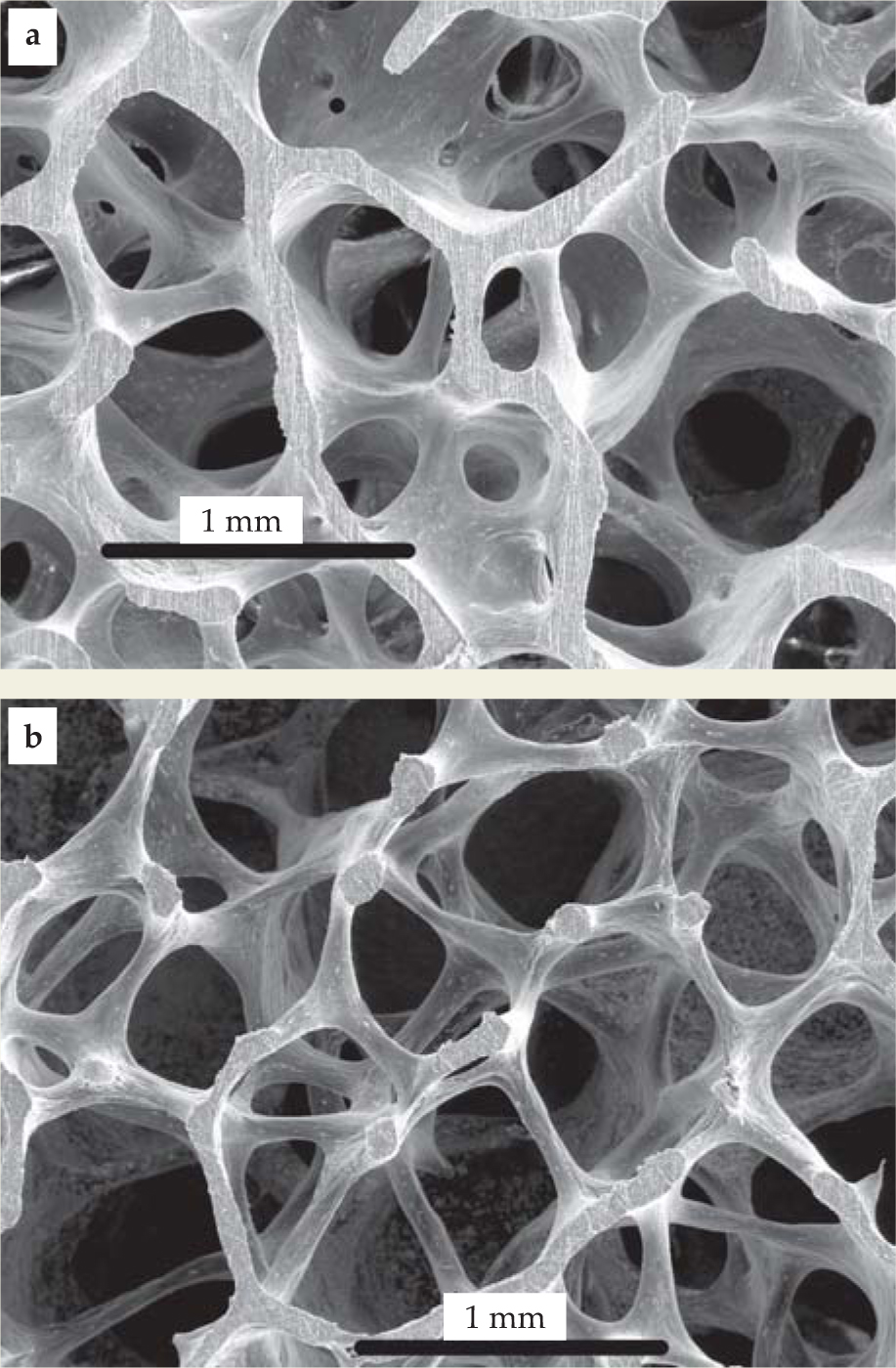
Bridging theory, measurement, and application
The complexity of bone has stifled researchers’ efforts to reach a complete, quantitative understanding of how it deforms and fractures in light of the salient plasticity and toughening mechanisms active at the various length scales. The emergence of better observational and computational tools, however, is allowing researchers to bring advanced techniques to bear on their analysis of bone.
Such studies may impact the medical field directly by revealing insights into bone-related diseases, aging, and the remodeling properties of bone. More specifically, by undertanding how micro- and macroscale features control bone’s physiology, researchers may find new cures and treatment options. For example, if a lack of glue-like molecules in the interfibrillar matrix is found to correlate with fracture risk, then increasing the abundance of those molecules would be a new target for drug therapy. Other applications may be found in the field of biomaterials, where the development of bone replacement tissues remains a grand challenge.
Many critical issues remain unresolved. Most importantly, researchers still lack rigorous models that link structure with properties—in particular, the role of nanostructural arrangements of bone in its macroscopic behavior. Finding that link is an exciting opportunity to bridge the gaps not only in our understanding of bone but also in the variety of other biological and natural materials—wood, nacre (mother-of-pearl), and spider silk among them—that contain similar hierarchical structures.
Advances in experimental techniques such as atomic force microscopy and optical tweezers are contributing to our understanding of bone and other key biological materials. Major challenges include carrying out measurements at multiple length and time scales and developing models that capture the dynamical properties of bone. Even greater challenges include the description of bone as a living material that remodels, adapts, and responds to a variety of biochemical and mechanical cues. Most existing physics models are not yet capable of describing such complex behavior. However, perhaps an interdisciplinary approach—the integration of systems theory, systems biology, and materials science—may forge a path to quantitative models of the material.
We acknowledge financial support from the National Institutes of Health and NSF. We thank Philipp Thurner and Georg Fantner for useful discussions.
We acknowledge financial support from the National Institutes of Health and NSF. We thank Philipp Thurner and Georg Fantner for useful discussions.
References
1. D. Taylor, in Comprehensive Structural Integrity: Fracture of Materials from Nano to Macro, vol. 9, I. Milne, R. O. Ritchie, B. L. Karihaloo, eds., Elsevier/Pergamon, Boston (2003), p. 35.
2. S. L. Hui, C. W. Slemenda, C. C. Johnston, J. Clin. Invest. 81, 1804 (1988). https://doi.org/10.1172/JCI113523
3. G. M. Kiebzak, Exp. Gerontol. 26, 171 (1991). https://doi.org/10.1016/0531-5565(91)90010-J
4. J.-Y. Rho, L. Kuhn-Spearing, P. Zioupos, Med. Eng. Phys. 20, 92 (1998); https://doi.org/10.1016/S1350-4533(98)00007-1
S. Weiner, H. D. Wagner, Annu. Rev. Mater. Sci. 28, 271 (1998); https://doi.org/10.1146/annurev.matsci.28.1.271
J. Currey, in Collagen: Structure and Mechanics, P. Fratzl, ed., Springer, New York (2008), chap. 14;
P. Fratzl, R. Weinkamer, Prog. Mater. Sci. 52, 1263 (2007). https://doi.org/10.1016/j.pmatsci.2007.06.0015. M. J. Buehler, S. Keten, T. Ackbarow, Prog. Mater. Sci. 53, 1101 (2008). https://doi.org/10.1016/j.pmatsci.2008.06.002
6. M. J. Buehler, J. Mech. Behav. Biomed. Mater. 1, 59 (2008);https://doi.org/10.1016/j.jmbbm.2007.04.001
A. Gautieri, M. J. Buehler, A. Redaelli, J. Mech. Behav. Biomed. Mater. 2, 130 (2009).https://doi.org/10.1016/j.jmbbm.2008.03.0017. D. Taylor, J. G. Hazenberg, T. C. Lee, Nat. Mater. 6, 263 (2007). https://doi.org/10.1038/nmat1866
8. W. Wagermaier et al., Biointerphases 1, 1 (2006).https://doi.org/10.1116/1.2178386
9. M. J. Buehler, Nanotechnology 18, 295102 (2007). https://doi.org/10.1088/0957-4484/18/29/295102
10. H. S. Gupta et al., Int. J. Fract. 139, 425 (2006). https://doi.org/10.1007/s10704-006-6635-y
11. B. L. Smith et al., Nature 399, 761 (1999); https://doi.org/10.1038/21607
G. E. Fantner et al., Biophys. J. 90, 1411 (2006). https://doi.org/10.1529/biophysj.105.06934412. R. K. Nalla et al., Mater. Sci. Eng. C 26, 1251 (2006). https://doi.org/10.1016/j.msec.2005.08.021
13. R. O. Ritchie, Int. J. Fract. 100, 55 (1999). https://doi.org/10.1023/A:1018655917051
14. R. K. Nalla, J. H. Kinney, R. O. Ritchie, Nat. Mater. 2, 164 (2003); https://doi.org/10.1038/nmat832
K. J. Koester, J. W. Ager III, R. O. Ritchie, Nat. Mater. 7, 672 (2008). https://doi.org/10.1038/nmat222115. R. K. Nalla et al., Bone 35, 1240 (2004).https://doi.org/10.1016/j.bone.2004.07.016
16. J. D. Currey, Bones: Structure and Mechanics, Princeton U. Press, Princeton, NJ (2002).
17. P. J. Thurner et al., Eng. Fract. Mech. 74, 1928 (2007). https://doi.org/10.1016/j.engfracmech.2006.05.024
18. R. K. Nalla et al., J. Biomech. 38, 1517 (2005). https://doi.org/10.1016/j.jbiomech.2004.07.010
More about the Authors
Rob Ritchie is a professor of materials science at the University of California, Berkeley, and a senior scientist at Lawrence Berkeley National Laboratory.
Markus Buehler is a professor in the department of civil and environmental engineering at the Massachusetts Institute of Technology in Cambridge.
Paul Hansma is a professor of physics at the University of California, Santa Barbara.
Robert O. Ritchie. 1 University of California, Berkeley, California, US .
Markus J. Buehler. 2 Massachusetts Institute of Technology, Cambridge, US .
Paul Hansma. 3 University of California, Santa Barbara, US .
